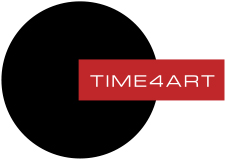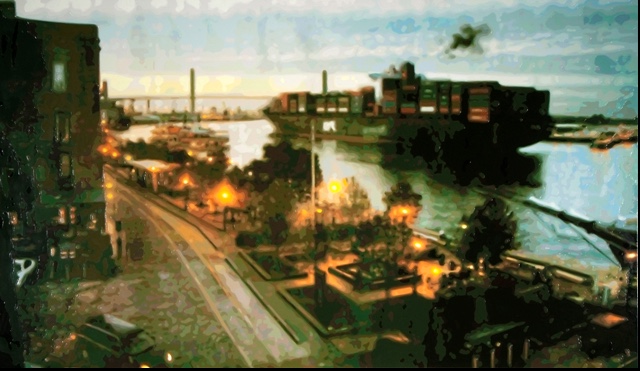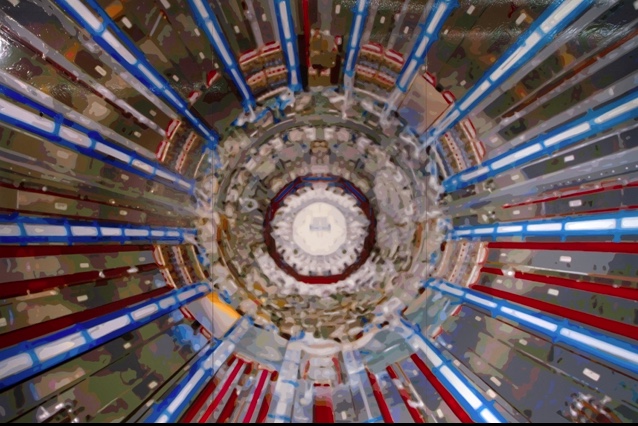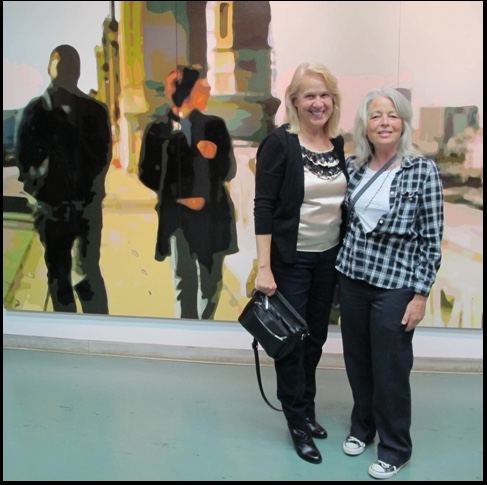PRESS CLIPS
It’s a Never-Ending Journey
Enamel Paintings by Timothy Tompkins are on view in Manhattan Beach
November 22, 2013 by Bondo Wyszpolski
Artist Timothy Tompkins. Photo by Bondo Wyszpolski
Timothy Tompkins was ten years old when “Star Wars” was released, and the movie changed his life. He attempted to duplicate one of the posters advertising the film, and this instilled in him “that sense of creativity that drives you to want to manifest something.” And that’s how it all began.
Tompkins is currently the subject of a concise retrospective, curated by Homeira Goldstein, which opened last week at the CreativeArtsCenter in Manhattan Beach. At the opening reception, Tompkins spoke eloquently about the work, his materials, his method of painting, and what inspires him.
The exhibition spans ten years, beginning with a large piece – I can’t really call it a canvas since this one, and all the others, are painted on one-eighth-inch-thivk aluminum panels – entitled “4th Street Over-Cross (after Canaletto).” It’s a large work (96” x 114”), which helped Tompkins secure his BFA from OtisCollege of Art and Design in 2003. The reference is to Gustave Caillebotte’s “Le Pont de l’Europe” (1877). The origins of Tompkin’s piece is a photograph of friends, taken in downtown Los Angeles.
In fact, all of the work is photo-based, some of it shot by the artist but mostly appropriated by him from other sources. “I scan these images into the computer,” he said at the opening, “and I use a commercial sign enamel to paint them onto the surfaces.” Elaborating further, “I’ve played around with acrylics and oils, but I’ve always loved the way enamel works. I love the feel of it in the brush, and in a sense that’s when I’m manipulating the pieces; for me it’s a very natural medium to use. I feel like it’s just like running your hands in wet paint all the time. Even when it dries it still looks like it’s wet to the touch.”
It’s safe to say that the majority of artists paint with their canvas or panel upright, often on an easel. Tompkins, however, creates his picture as it lies on the floor, which allows him to better control the movement of the paint.
“Because I work flat,” he said, “the paint actually has a self-leveling property built into it.” The texture, therefore, doesn’t have that kind of heavy impasto that literally gives body to many modern works (like Cezanne’s or Van Gogh’s), instead becoming glossy and often vibrant, like fingernail polish or the surface of a shiny new car.
The smallest paintings in “Super Collider” are 31” x 24” and that’s still a decent size. The larger ones, as indicated, are more like junior billboards. So how much time does Tompkins spend on his work?
“Depending on the size,” he said, “(it takes) anywhere from two weeks to two months. These big paintings would take six weeks or so. It seems I’m always painting under a deadline. So, I always have that motivation for pushing and pushing. If I didn’t have it I’d probably take half a year to do a painting.”
He makes an impression
Although she’d noticed his work at Otis in 2003, Homeira Goldstein began to be more keenly aware of Tompkins a couple of years later.
“In October, 2005, I was holding a fundraising event with performance art for Otis at our home and wanted to display some of the Otis graduates’ work around the house. I was presented with a number of artworks to choose from.” Tompkins’ paintings were among those offered. “I was again intrigued by his work,” Goldstein says, “and he was one of the two artists I chose.”
They were in contact over the next few years, and Goldstein developed an appreciation for Tompkins’ talent and creative process.
“At the beginning of 2013 he told me he was working on a new series and he showed me some images,” Goldstein says. “Then I knew it was time to have a show of his work for ARTS Manhattan.”
She elaborates on what draws her to it: “My inspiration and fascination for Tim’s work comes from my own quest for internal visualization of either circumstances or real still life of the outer world. A process that has some mystical connotation for me, representing [my] personal journey in seeing everything, made up or real, in my third eye. A process that has helped me with my own creations.”
Series spawning series
“The accumulation of all these images is kind of like the accumulation of memories in my life,” Tompkins explained. He was embarked on a number of series, many of them seemingly ongoing, and a number of them – like his “4th Street Over-Cross (after Callebotte)” – reference works by the Impressionists (Monet seems to be a favorite) and others more distant, for instance Canaletto and Chardin.
For example, his “Sears” series was inspired by Monet’s pictures of the Rouen cathedral façade that were painted in the 1890s at different times of the day and in different weather conditions. In this case, Tompkins alighted upon the Sears building in downtown Los Angeles. Two of these works, dating from 2010, are in the current show. Because of his computer and graphic design background, Tompkins likens what he creates here to Techno-Impressionism.
A related series, “Power Generators,” was inspired by Monet’s pictures of a grove of poplars near the river Epte. From a distance, the one on view resembles the columns of a ruined temple, but the actual site that Tompkins selected is the Haynes Power Generating Facility in Long Beach.
The “Left Overs” series is certainly the most whimsical of the bunch, even though it references the exquisite still lifes of Chardin. The artist goes into department stores like Target and then rearranges their leftover merchandise before photographing it. This might be Halloween or Thanksgiving or Christmas or Easter merchandise that nobody purchased and now it’s sort of jumbled all together. Tompkins, in a way, is taking pity on these objects, and the result is something of a painterly meditation on the disposability of objects in our consumer culture.
The “Media” series, represented by “1.30.08 (after Canaletto)” from 2009, consists of front page images taken from the New York Times or the Los Angeles Times in which Tompkins discerns a connection to art history. As he described it, these ephemeral images are given a new life by his re-appropriating them into the language of painting.
“I have lots of images that I just collect and go through… that I kind of live with for a while and then I play around with them. But there are other times when something just grabs you, especially with the ‘Media’ paintings, because my internal radar” is always on the alert for a compelling image.
The “Nebula” series encompasses images of stellar objects based on the so-called Hubble Palette, which is what scientists resort to when they want to depict different objects in space not visible to the naked eye, such as dust clouds, gas, and plasma. It is, as Tompkins put it, “a way to kind of reveal the unseen.”
The “Super Collider” series, he noted, “is a body of work I started earlier this year, based on images of the Large Hadron Collider in Switzerland,” but also “referencing Gothic architecture” and the language of architecture so that his work connects “contemporary theories of physics with timeless concepts of the human condition and spirituality.” Tompkins is fascinated by the “ongoing dialogue with Man’s need to discover the origins of life. And I’m really intrigued by the symmetry of these images.”
Unlike some artists, Tompkins always knows where he’s going with each painting.
“I see the end point at the beginning because of the way I work. But I always like to leave a little something unfinished because I don’t like that big sense of closure. So there’s always something in the work – which I’ll never say – that I just kind of hold back a little bit.
“Sometimes when I look at the work, especially these new pieces, it’s overwhelming to see what the end product is supposed to be, because it puts a lot of pressure on me as an artist to kind of get it to that point. It’s like one paint stroke at a time and, just like walking somewhere on a journey, you’re concentrating on the journey and not so much the destination.”
Well, the current exhibition may not be the final destination, but it’s certainly a dazzling way station where we can contemplate and ponder.
SUPER COLLIDER, work by TIMOTHY TOMPKINS, presented by ARTS MANHATTAN, is on view through Jan. 16 in the Creative Arts Center, 1560 Manhattan Beach Blvd., MB. Hours, Tuesday and Thursday from 2 to 6, Wednesday from 4 to 8, and Saturday from 1 to 5 p.m. Closed Sunday, Monday, Friday, and holidays.




